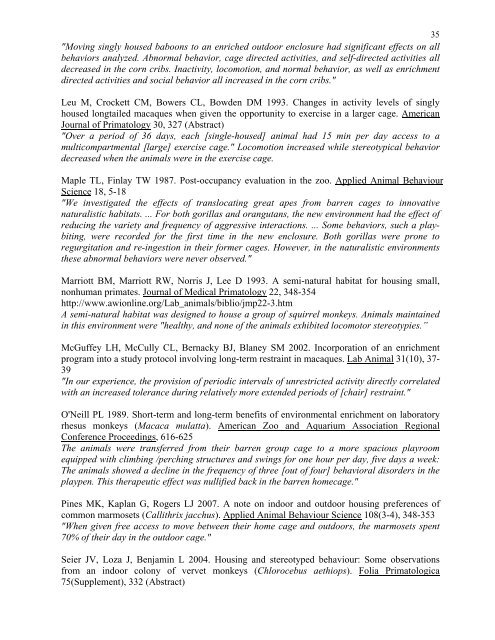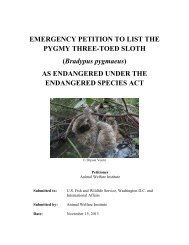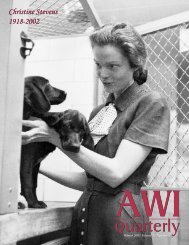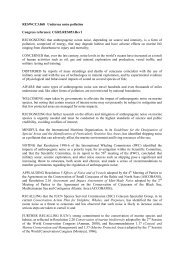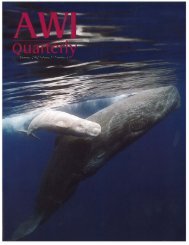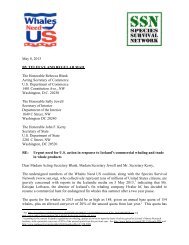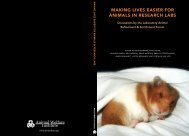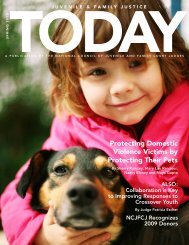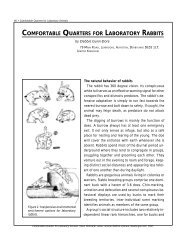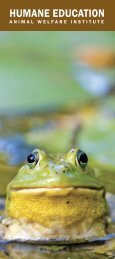35"Moving singly housed baboons to an enriched outdoor enclosure had significant effects on allbehaviors analyzed. Abnormal behavior, cage directed activities, a<strong>nd</strong> self-directed activities alldecreased in the corn cribs. Inactivity, locomotion, a<strong>nd</strong> normal behavior, as well as enrich<strong>ment</strong>directed activities a<strong>nd</strong> social behavior all increased in the corn cribs."Leu M, Crockett CM, Bowers CL, Bowden DM 1993. Changes in activity levels of singlyhoused longtailed macaques when given the opportunity to exercise in a larger cage. AmericanJournal of <strong>Prima</strong>tology 30, 327 (Abstract)"Over a period of 36 days, each [single-housed] animal had 15 min per day access to amulticompart<strong>ment</strong>al [large] exercise cage." Locomotion increased while stereotypical behaviordecreased when the animals were in the exercise cage.Maple TL, Finlay TW 1987. Post-occupancy evaluation in the zoo. Applied Animal BehaviourScience 18, 5-18"We investigated the effects of translocating great apes from barren cages to innovativenaturalistic habitats. ... For both gorillas a<strong>nd</strong> orangutans, the new environ<strong>ment</strong> had the effect ofreducing the variety a<strong>nd</strong> frequency of aggressive interactions. ... Some behaviors, such a playbiting,were recorded <strong>for</strong> the first time in the new enclosure. Both gorillas were prone toregurgitation a<strong>nd</strong> re-ingestion in their <strong>for</strong>mer cages. However, in the naturalistic environ<strong>ment</strong>sthese abnormal behaviors were never observed."Marriott BM, Marriott RW, Norris J, Lee D 1993. A semi-natural habitat <strong>for</strong> housing small,nonhuman prim<strong>ates</strong>. Journal of Medical <strong>Prima</strong>tology 22, 348-354http://www.awionline.org/Lab_animals/biblio/jmp22-3.htmA semi-natural habitat was designed to house a group of squirrel monkeys. Animals maintainedin this environ<strong>ment</strong> were "healthy, a<strong>nd</strong> none of the animals exhibited locomotor stereotypies.”McGuffey LH, McCully CL, Bernacky BJ, Blaney SM 2002. Incorporation of an enrich<strong>ment</strong>program into a study protocol involving long-term restraint in macaques. Lab Animal 31(10), 37-39"In our experience, the provision of periodic intervals of unrestricted activity directly correlatedwith an increased tolerance during relatively more exte<strong>nd</strong>ed periods of [chair] restraint."O'Neill PL 1989. Short-term a<strong>nd</strong> long-term benefits of environ<strong>ment</strong>al enrich<strong>ment</strong> on laboratoryrhesus monkeys (Macaca mulatta). American Zoo a<strong>nd</strong> Aquarium Association <strong>Re</strong>gionalConference Proceedings, 616-625The animals were transferred from their barren group cage to a more spacious playroomequipped with climbing /perching structures a<strong>nd</strong> swings <strong>for</strong> one hour per day, five days a week:The animals showed a decline in the frequency of three [out of four] behavioral disorders in theplaypen. This therapeutic effect was nullified back in the barren homecage."Pines MK, Kaplan G, Rogers LJ 2007. A note on i<strong>nd</strong>oor a<strong>nd</strong> outdoor housing preferences ofcommon marmosets (Callithrix jacchus). Applied Animal Behaviour Science 108(3-4), 348-353"When given free access to move between their home cage a<strong>nd</strong> outdoors, the marmosets spent70% of their day in the outdoor cage."Seier JV, Loza J, Benjamin L 2004. Housing a<strong>nd</strong> stereotyped behaviour: Some observationsfrom an i<strong>nd</strong>oor colony of vervet monkeys (Chlorocebus aethiops). Folia <strong>Prima</strong>tologica75(Supple<strong>ment</strong>), 332 (Abstract)
36The animals “spent most time in stereotypies when in unenriched single cages. This wassignificantly reduced by the provision of either an exercise cage or a <strong>for</strong>aging log. Nostereotyped behaviour was observed in the largest most enriched cages.“Storey PL, Turner PV, Tremblay JL 2000. <strong>En</strong>viron<strong>ment</strong>al enrich<strong>ment</strong> <strong>for</strong> rhesus macaques: Acost-effective exercise cage. Contemporary Topics in Laboratory Animal Science 39(1), 14-16“Increased visual attentiveness by other animals, decreased self-directed biting a<strong>nd</strong> hairpicking, a<strong>nd</strong> improved food consumption was observed when rhesus macaques were permittedaccess to an exercise cage <strong>for</strong> several hours daily."Tustin GW, Williams LE, Brady AG 1996. Rotational use of a recreational cage <strong>for</strong> theenviron<strong>ment</strong>al enrich<strong>ment</strong> of Japanese macaques (Macaca fuscata). Laboratory <strong>Prima</strong>teNewsletter 35(1), 5-7http://www.brown.edu/<strong>Re</strong>search/<strong>Prima</strong>te/lpn35-1.html#tustinThe rotational use of a “recreation cage” resulted in increased use of enrich<strong>ment</strong> devices a<strong>nd</strong> adecrease in stereotypical behaviors.Wilkes MN, Lynch CS, Fontenot MB 2006. Outdoor housing decreases self-injurious a<strong>nd</strong>stereotypic behavior in adult male rhesus macaques (Macaca mulatta). American Journal of<strong>Prima</strong>tology 68(Supple<strong>ment</strong>), 106 (Abstract)Access to an outdoor area decreased self-injurious a<strong>nd</strong> stereotypical behaviors in adult malerhesus who had been single-caged or group-housed i<strong>nd</strong>oors.(3) Inanimate a<strong>nd</strong> Feeding <strong>En</strong>rich<strong>ment</strong>Baker KC 1997. Straw a<strong>nd</strong> <strong>for</strong>age material ameliorate abnormal behaviors in adult chimpanzees.Zoo Biology 16, 225-236"In an [successful] ef<strong>for</strong>t to reduce abnormal behaviors, especially regurgitation a<strong>nd</strong>reingestion, a<strong>nd</strong> promote higher activity levels [locomoting a<strong>nd</strong> playing], straw a<strong>nd</strong> scattered<strong>for</strong>age material were added to the enclosures of 13 i<strong>nd</strong>oor-housed chimpanzees living in pairsa<strong>nd</strong> trios."Baker KC, Springer DA 2006. Frequency of feeding enrich<strong>ment</strong> a<strong>nd</strong> response of laboratorynonhuman prim<strong>ates</strong> to unfamiliar people. Journal of the American Association <strong>for</strong> LaboratoryAnimal Science [Contemporary Topics in Laboratory Animal Science] 45(1), 69-73"The data presented support the hypothesis that levels of treat feeding influence monkeys'receptivity to unfamiliar people."Bayne K, Dexter SL, Mainzer H, McCully C, Campbell G, Yamada F 1992. The use of artificialturf as a <strong>for</strong>aging substrate <strong>for</strong> i<strong>nd</strong>ividually housed rhesus monkeys (Macaca mulatta). AnimalWelfare 1, 39-53http://www.awionline.org/Lab_animals/biblio/aw1-39.htm"An increasing tre<strong>nd</strong> in time spent <strong>for</strong>aging with a concomitant decline in aberrant behaviourover a time period of six months was particularly noteworthy [in the single-housed subjects]."Bayne K, Dexter S, Suomi S 1992. A preliminary survey of the incidence of abnormal behaviorin rhesus monkeys (Macaca mulatta) relative to housing co<strong>nd</strong>ition. Lab Animal 21(5), 38-46"The gre<strong>ates</strong>t frequency of overall abnormal behavior a<strong>nd</strong> stereotypic exploratory behavior wasin the SC [single cage] co<strong>nd</strong>ition, a<strong>nd</strong> the lowest frequency of occurrence in the CC [corn crib]co<strong>nd</strong>ition ... in IO [i<strong>nd</strong>oor/outdoor] runs, the animals showed no self-directed behavior."
- Page 3: Table of ContentsSpecies-typical Be
- Page 7 and 8: 2Behavioral Pathologies (Abnormal B
- Page 9 and 10: Meyerson BJ 1986. Ethology in anima
- Page 11 and 12: 6"An animal treated unsympathetical
- Page 13 and 14: 8"If sufficient room is not provide
- Page 15 and 16: Canadian Council on Animal Care 198
- Page 17 and 18: 12Platt DM, Kinsey JH, Jorgenson MJ
- Page 19 and 20: 14(7) Enforced RestraintAdams MR, K
- Page 21 and 22: 16Goosen DJ, Davies JH, Maree M, Do
- Page 23 and 24: Norman RL, McGlone J, Smith CJ 1994
- Page 25 and 26: 20Crockett CM, Bowers CL, Shimoji M
- Page 27 and 28: 22(10) Double-tier Cage Arrangement
- Page 29 and 30: National Research Council 1998. The
- Page 31 and 32: 26Coe CL 1991. Is social housing of
- Page 33 and 34: 28Tatoyan SK, Cherkovich GM 1972. T
- Page 35 and 36: 30Line SW, Morgan KN, Markowitz H,
- Page 37 and 38: 32Reinhardt V 1989. Evaluation of t
- Page 39: 34Clarke AS, Juno CJ, Maple TL 1982
- Page 43 and 44: 38Brent L, Belik M 1997. The respon
- Page 45 and 46: 40"Access to the puzzles was accomp
- Page 47 and 48: 42"The purpose of this study was to
- Page 49 and 50: 44Choi GC 1993. Humans enrich the l
- Page 51 and 52: 46“Eleven baboons who had been si
- Page 53 and 54: 48Reinhardt V, Houser WD, Eisele S,
- Page 55 and 56: 50Thompson MA, Bloomsmith MA, Taylo
- Page 57 and 58: (7) Working with Cooperative Animal
- Page 59 and 60: 54Lambeth SP, Hau J, Perlman JE, Ma
- Page 61 and 62: 56Smith M, Barley J, Down N, Franci
- Page 63 and 64: Environmental Enrichment58(1) Defin
- Page 65 and 66: 60Baker KC, Seres M, Aureli F, de W
- Page 67 and 68: 62Judge PG, de Waal BM, Paul KS, Go
- Page 69 and 70: (2,1,b) Group-housing: Group Format
- Page 71 and 72: 66McNary JK 1992. Integration of ch
- Page 73 and 74: 68Clarke MR, Blanchard JL 1994. All
- Page 75 and 76: Watts E 1997. Introductions. In Ora
- Page 77 and 78: 72Baumans V, Coke C, Green J, Morea
- Page 79 and 80: 74Hotchkiss CE, Paule MG 2003. Effe
- Page 81 and 82: 76Reinhardt V, Hurwitz S 1993. Eval
- Page 83 and 84: 78Shively CA 2001. Psychological we
- Page 85 and 86: 80“The establishment of dominance
- Page 87 and 88: 82Reinhardt V 1991. Agonistic behav
- Page 89 and 90: Abney D, Conlee K, Cunneen M, Down
- Page 91 and 92:
86Boccia ML, Broussard C, Scanlan J
- Page 93 and 94:
Southey ER, Baldwin CM 2006. Social
- Page 95 and 96:
T-W-Fiennes RN 1972. Primates - Gen
- Page 97 and 98:
927 to 44 training sessions. .. The
- Page 99 and 100:
94Baumans V, Coke C, Green J, Morea
- Page 101 and 102:
96Skoumbourdis EK 2008. Pole-and-co
- Page 103 and 104:
98Tamarins (Saguinus spp.)Smith TE,
- Page 105 and 106:
100Bertrand F, Seguin Y, Chauvier F
- Page 107 and 108:
102Gilloux I, Gurnell J, Shepherdso
- Page 109 and 110:
104Molzen EM, French JA 1989. The p
- Page 111 and 112:
106Reinhardt V 1992. Foraging for c
- Page 113 and 114:
108Boccia ML 1989. Long-term effect
- Page 115 and 116:
110Baumans V, Coke C, Green J, More
- Page 117 and 118:
112”We give our pair-housed cynos
- Page 119 and 120:
114use their hands to obtain and pr
- Page 121 and 122:
116MacLean E, Roberts Prior S 2006.
- Page 123 and 124:
Bayne K, Hurst JK, Dexter SL 1992.
- Page 125 and 126:
120Phillippi-Falkenstein K 1998. Us
- Page 127 and 128:
122Shimoji M, Bowers CL, Crockett C
- Page 129 and 130:
Anonymous 1991. The psychological w
- Page 131 and 132:
126Pruetz JD, Bloomsmith MA 1992. C
- Page 133 and 134:
128Reinhardt V 1990. Time budget of
- Page 135 and 136:
130O'Neill PL, Wright AC, Weed JL 1
- Page 137 and 138:
132above ground level. I very often
- Page 139 and 140:
134Canadian Council on Animal Care
- Page 141 and 142:
136International Primatological Soc
- Page 143 and 144:
138forage daily, by scattering food
- Page 145 and 146:
140sensory and emotional experience
- Page 147 and 148:
142Bayne K 1989 Resolving issues of
- Page 149 and 150:
144creation? Very unlikely!I think
- Page 151:
146Spaeth GL 1994. Editorial: Carin


